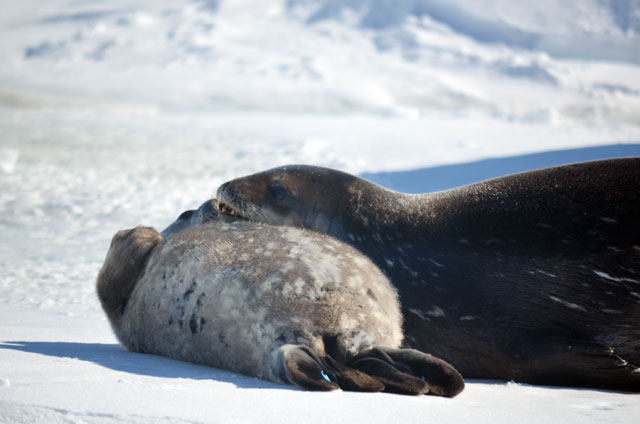|
Getting techieWeddell seal population dynamics study employs different technologiesPosted February 10, 2012
A long-term study of the Weddell seal population in McMurdo Sound is returning to its cutting-edge technological roots. A team of researchers from the University of Minnesota But now the current research team, led by Robert Garrott and Jay Rotella at Montana State University (MSU) On one end has been the use of temperature tags on Weddell seal pups. About 50 of the small sensors were successfully recovered at the end of the 2011-12 season. The device, as the name implies, constantly records temperature. The data appear in a simple graph. The “x” axis is time, while the “y” axis shows temperature. The water temperature in McMurdo Sound remains a constant minus 1.8 degrees Celsius, so the tags can tell the researchers when and for how long the pups are in the water. Graphic Credit: WeddellSealScience.com
Data from a temmperature sensor tag shows when a Weddell seal pup was in the water and for how long.
The ecologists are interested in learning how old the pups are when they first start swimming, as well as the average duration of each swim, according to Jesse DeVoe The team is investigating whether pups that spend more time in the water learning to swim with their mothers have a higher probability of surviving, eventually returning to the colony to breed. “The data retrieved so far shows lots of swimming pups,” DeVoe wrote on the team’s research blog. While the temperature tags help the researchers follow the seal pups under water, satellites high in the sky are giving them a new way of seeing the seals at the ice surface. The MSU team is collaborating with researcher Michelle LaRue LaRue is working to use remote sensing techniques to research populations of seals and penguins. The MSU team is helping ground-truth the satellite data, including the use of cameras where seals haul out of the water through holes in the sea ice. DeVoe reviews the photos from the entire field season, identifying the haul-out patterns of the seals for parallel times that the satellites are collecting imagery from space. “We’re trying to get a correction factor for her satellite imagery,” DeVoe said. Garrott sees an opportunity to use the satellite data to learn about seal populations over much broader spatial scales, especially in areas that are otherwise impossible to access. “That’s one of the things a science program like this should do,” he said. “There should be that kind of synergy where we do one thing and another group comes in with certain technology, and by working together, we can advance the science in a whole different direction than we could do if we worked alone.” NSF-funded research in this story: Robert Garrott, Jay Rotella, and Donald Siniff, Montana State University, Award No. 0635739 Return to main story — Sealed and delivered: Long-term population study of Weddell seals makes some 'super' discoveries |



For USAP Participants |
For The Public |
For Researchers and EducatorsContact UsU.S. National Science FoundationOffice of Polar Programs Geosciences Directorate 2415 Eisenhower Avenue, Suite W7100 Alexandria, VA 22314 Sign up for the NSF Office of Polar Programs newsletter and events. Feedback Form |


